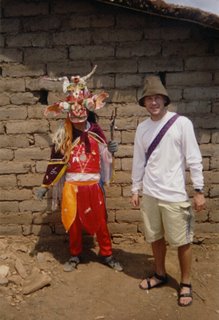 Here are some brief descriptions for the Matchbox paintings posted on this site along with a few photos from Bolivia.
Here are some brief descriptions for the Matchbox paintings posted on this site along with a few photos from Bolivia.I am really hoping that I can give a better understanding of the high valley areas of Chuquisaca, Bolivia. Sucre is the original capital of Bolivia. !Viva Bolivia!
Please support my fundraising effort to support Two Wheel View. The actual Matchbox paintings as well as more information on Two Wheel View can be found by scrolling down. www.twowheelview.org.
Thank you for your support!
-Kekoa Rosa
Matchbox paintings A1 - A16
A1 – A3: Campesinos
These are the local campesinos who would gather and haul firewood for my community.
They are all men and they have large bunches of branches and small twigs bound together with either leather rope or rubber straps. They usually carried a machete or ax with them. These men would haul one load and receive somewhere between $.75 - $1.50 depending on size. They often walked for miles bent with a large bunch of twigs. I would often catch them on the dirt roads right out of town with there packs off their backs.
A4 Campesino
These are the A-typical Bolivian high-valley Cowboys and Cowgirls known as Campesino’s and Cholita’s respectively. He wears his black felt hat, red bandana, leather rope, coca bag on side, canvas shorts and tire sandals. She wears a finely croqueted white blouse with a pleated purple skirt. She is holding what was to be a dove. I mixed charcoal in the paint for the background.
A7 & A8 Cholita chef and baker
A9 Cholita with bollo hat
A10 – A12 More Cholitas
A13 Horse
A14 Collage
A15 Campesino at a party.
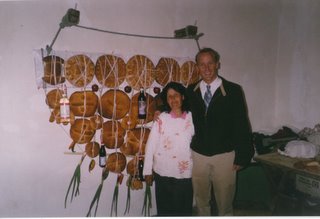
I remember really enjoying laying this painting out. On the left is an “Arca”. This is a hanging collection of breads, wines, grapes, cheese, onions and many other things that you would definitely see at all major holidays like Easter and parties for their patron Saints. It symbolizes everything that has given them sustenance and life. It is often celebrated with giving thanks to Pacha Mama (earth mother) by splashing a bit of chicha (corn beer) on the floor and is served from a plastic pail.
Matchbox paintings B1 - B10
B1 Cholita Mollering
I believe this was my first of this design with the cholita’s back to you. Her braided hair is tied together at the back. She stands over her stone and rolls a curved stone over the flat stone to grind her food. The smoke rising from the oven makes a familiar animal; maybe a ox or cow. The afternoon shifts slowly to night.
B2 Virgin on half-shell
This is a statue that can be viewed from the main plaza in 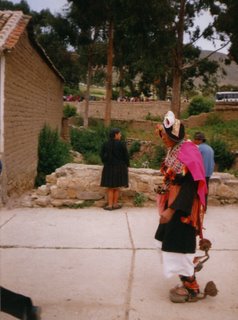
B3 Traditional Trabucco Carnival outfit for men
This is the traditional garb worn by men. They wear a leather cap that is hard as rock and resembles the metal hat of a conquistador soldier. Upon the cap are three paper-mache flowers with pistal of wire. The dress is very colorful. He carries a red pouch that he wears under his right arm usually for coca. Not shown here but their shoes are like a wooden clog with long and loud spurs off the back of them.
B4 & right below it B 8 Cholita weavers
Cholita weaving her tapestry. The women in this region are extremely talented with this traditional weaving. Many of the scenes they depict are mythical creatures. The weaving is tedious and all done by hand. The wool is also often hand wound and dyed.
B5 Reed hut
This is a traditional reed grass hut found on the floating islands outside of
B6 Campesino
Similar to A5. Black felt hat with black parka and plastic coca bag hanging off his side.
B7 Companion Campesinos
These two campesinos take the local country transportation: their feet and friendship.
B8* Cholita Weaver
Refer to B4
B9 Franciscan church and yard
Traditional Franciscan hacienda style church and yard. I believe the original church was destroyed in an earthquake. They have the feel of the
The town plaza sits in front of the church.
B10 Pigs on Lago Titicaca
Pigs are usually free during the day to feed on trash picked over fields. On the lake a fisherman sails his single bright blue triangular sail. A very popular dish especially on the weekends and usually on Sunday is Chicharon. It is a huge cauldron where they deep fry pig parts. Usually served with chicha and corn on the cob.
Matchbox Paintings on Page C
C1 - C16
Painting C1
Sajama is
C2 Gnarled tree
Some of these trees in the countryside offer excellent shade for animals and humans. Often times the farmers will store hay in the trees to keep animals away from them.
C3 Plowed field at dusk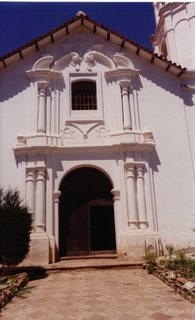
C5 Church entrance
C7 Cholita on a stroll
C8 Cholita in town
C9 Oxen with yokes
This is an amazing thing to see. All of the components of a Campesino’s plow are made of wood. These farmers usually carve their own plowing spears often mounting a metal spike at the end if the earth is particularly dry. I never did try this but the farmers who had it down were extremely efficient. During planting the campesino controls his oxen and plow. A cholita will often follow behind with a basket full of seeds planting right behind. I have seen them use these plows once to till a potatoe field. The oxen walked the lanes between the potatoes plants and plants that were accidentally pulled up were quickly replanted by a trailing cholita.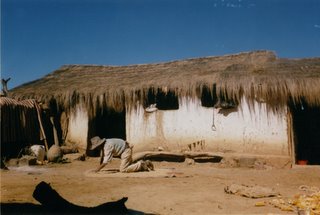
C10 Adobe house with a weaving
I was walking in the countryside and noticed this small adobe hut with grass (paja) roof and sitting up against the house was the most colorful weaving that was not yet completed. I would often see weavings propped up on trees which seems like a perfect place out of the sun.
C11 Fox
I used dabbed the colors on with a fine matchstick. I would often see fox (zorro’s). I never did see a bobcat or larger cat alive anyways. Once I was shown a large cat pelt that my neighbor shot years earlier. They are much more beautiful alive.
C13 Cross with Sacred Heart
C15 Sun
C16 Abstract
This was purely experimental. The scratch marks are actually ballpoint pen. The yellow is actually the paint underneath the gray.

